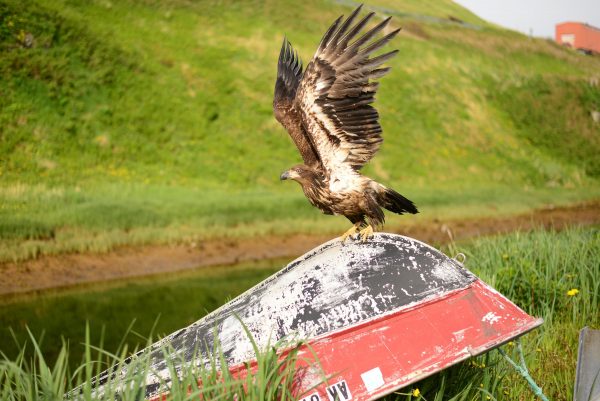
When bald eagles die in Unalaska, it’s the beginning of a long journey. Literally. Many of them travel thousands of miles and find second lives in the Lower 48.
When Damian Lopez-Plancarte walks into the Wildlife Trooper office and opens the freezer, it looks like Thanksgiving.
The shelves are jammed full of turkey-shaped items wrapped in plastic. But none of them are turkeys.
“Here we have one, two, three four, five dead eagles,” says Lopez Plancarte, counting each one..
When a raptor is found dead, he gets the call to remove the bird. He bags the carcass and stores it here, along with other freezer goods.
“That’s an ice cream sandwich,” he points out. “Keep ‘em in the same freezer.”
These eagles may have an unusual icy grave, but soon they’ll begin a journey that could take them more than 3000 miles across America. Why?
The Bald and Golden Eagle Protection Act of 1940 made it a federal crime for anyone to possess eagle parts — and the punishment is severe. Get caught with even one feather, and you could receive a $200,000 fine, a yearlong prison sentence, or both.
The exception is for members of federally recognized tribes, many of whom use eagle feathers, talons, and other parts in ceremonies or as spiritual objects.
But taking, transporting, and buying eagle parts is still illegal. So how are indigenous people supposed to get them?
The answer is the National Eagle Repository in Colorado. Dead eagles from across the nation are shipped there, including those from Unalaska.
Sarah Metzer works at the repository. Her job includes delivering educational programs and sorting through two giant walk-in freezers full of eagle carcasses.

“Wanting to ensure that we protect the constitutionally protected right of religious freedom, our facility turns those eagles around,” says Metzer. “We’re able to distribute the parts and feathers to members of federally recognized Native American tribes.”
Last year, she says the repository received 2,700 eagles and filled nearly 4,000 orders. That’s more than seven eagles a day, and the rate keeps climbing.
“We’re looking at getting a third freezer,” says Metzer.
Most orders are from the Southwest, where the feathers are used for powwows and graduations, as well as gifts and headdresses.
“It’s a pretty special thing, knowing there’s a recipient on the other end,” says Metzer. “This eagle will live on, and its spirit will live on through that applicant.”
But the wait can be long and frustrating for those who feel the federal government shouldn’t be in charge of distributing ceremonial objects or regulating indigenous spirituality.
If you placed an order today, it would take six months to get a whole bald eagle. Half that for 20 loose feathers. A golden eagle takes more than two years.
That makes it tempting to pick feathers up off the beach. But now, indigenous people can do just that.
After decades of an informal policy to look the other way when Native Americans had non-repository feathers, the Justice Department issued a memo in 2012. It allows indigenous people to pick up and possess “culturally significant” eagle parts — even if they don’t come from the repository — as long as they don’t sell the parts or kill the eagles.
So while the repository does fill orders from Alaska, chances are slim that Unalaska’s eagles will find themselves back on the island in the afterlife.




